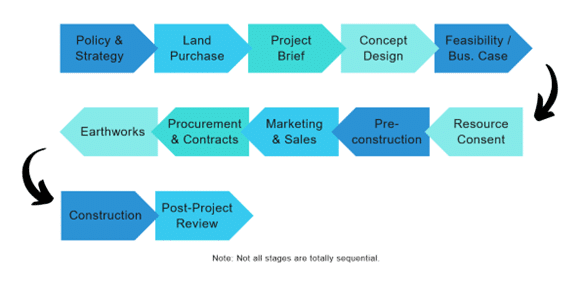Hot off the press from New Zealand Property Investor magazine, Leonie Freeman shares her view on the importance of connecting regulation with real-life development.
Property is New Zealand’s largest industry. As a sector, we employ 10% of New Zealand’s workforce and contribute over $50.2 billion to GDP. Yet embarking on even the simplest development project often feels like herding cats. If property drives our economy, how can we make development easier, more sustainable, and beneficial for all?
Development: A Long-Term Commitment
Contrary to popular belief, development doesn’t begin when the first shovel hits the ground. That’s the culmination of a lengthy process, with most projects never even reaching the construction phase. For those that do, the timelines are staggering.
The Development Process: At A Glance

A small residential project under 20 units might take 18-21 months:
- Concept design and approval: 3-4 months
- Resource consent development and processing: 4 months
- Contract negotiations and procurement: 3 months
- Construction: 8-10 months
Larger projects, like a 500+ unit development, can require three years just for master planning, with staged construction taking a decade or more. Some projects span decades. Overlay this with a three-year political cycle, and the impacts of regulatory shifts become clear. Add economic hiccups, material shortages, or labour constraints, and developers face extraordinary risks with no guaranteed reward.
The Key to Success: Certainty
We all share a vision for sustainable development that creates warm, dry homes, thriving workplaces, and opportunities for growth. But to achieve this, we need certainty.
Certainty stems from knowing the government’s long-term strategy, understanding local council growth plans, and having clarity around funding for key infrastructure projects. Shifting goalposts, such as sudden changes to seismic strengthening requirements, tinkering with tax rules or amended infrastructure planning undermine this certainty and create friction.
When certainty exists, development will follow. The private sector are often fast followers of public sector projects, as there’s nothing more certain than seeing plans come to fruition. Great alignment between public and private sectors fosters collaboration and better outcomes.
Opportunities in Connection
If we connect the dots effectively, the opportunities are enormous. From creating walkable, sustainable cities to implementing new housing models like Build-to-Rent, we could provide more New Zealanders with secure, long-term homes. Developers can mitigate risks, and communities can enjoy infrastructure that enhances their lives.
At the Property Council, our role is to bridge the gap between the property sector and government. By consulting on proposed legislation, plans, and policies early, we encourage regulatory changes that translate to practical success.
With certainty, collaboration, and vision, we can continue to transform our built environment into one that supports thriving communities and a resilient economy.
Author | Leonie Freeman
A well-respected industry leader, Leonie has extensive experience in the New Zealand property industry, having held top positions in both the public and private sector. From creating the concept of what is now realestate.co.nz, to buying and transforming her own residential property management business, helping establish the new Auckland Council, and managing asset development for Housing New Zealand, there’s not many areas of property that Leonie has not touched.
In 2011, Leonie was appointed to the board of NZX listed company Goodman Property Trust, and up until her 2018 appointment as Property Council’s Chief Executive, she dedicated her time to leading an independent philanthropic initiative to solve Auckland’s housing crisis.


